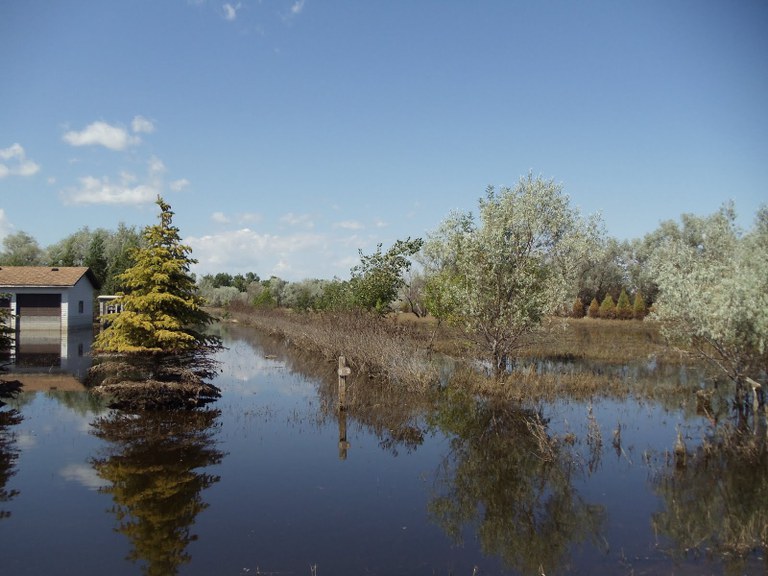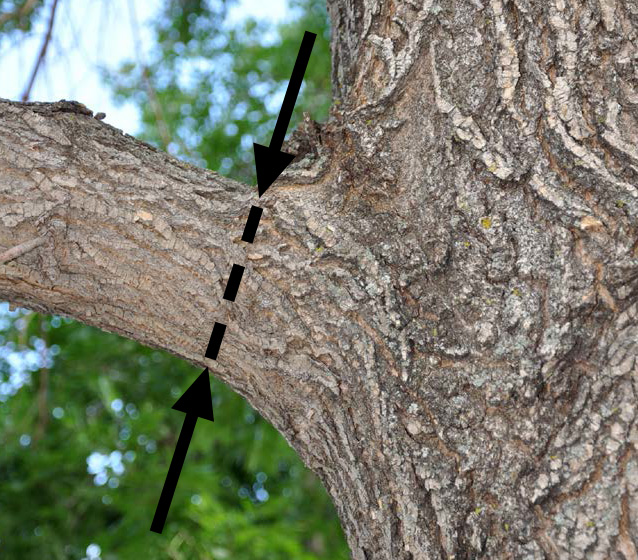Symptoms of flood damage
- Leaves – discoloration (yellowing), wilting, scorched appearance, early fall color or leaf drop (Flood symptoms are very similar to drought symptoms.)
- Branches – dieback of existing branches, sprouting of new branches from the trunk
Determining amount of damage
- Water – If the entire tree crown is or was covered with water for any amount of time, the tree likely will die. However, a high amount of oxygen in the water can reduce the damage:
- Fast-moving water contains more oxygen than slow-moving water.
- Shallow water warms quicker and loses more oxygen.
- Health of the tree – Very young and very old trees are unlikely to survive; previously healthy trees have a better chance at survival.
- Inspection – Use your thumbnail to scratch the bark from a young limb; if you find green tissue underneath, the plant is alive though there is no guarantee that it will recover.
- Season of flooding – Floods that occur in the dormant season will not harm trees.
Recovery of flood-damaged trees – reduce future stress
- Remove sediment that has accumulated on the soil surface.
- Fertilization – Lightly fertilize with up to 1 pound of nitrogen per 1,000 square feet of soil surface.
- Pests – Scout for insects and diseases and treat as necessary.
- Damaged bark – Remove loose bark and carefully trace around wounds with a sharp knife to remove loose bark; do not use pruning paints or wound sealers.
- Remove only dead branches and limbs. Do not top trees.
- Recovery – Trees or shrubs may take up to five years to recover.
Tree removal
- Flood-damaged trees may fall over in high winds because of weakened root systems and/or saturated soils.
- Hire a professional arborist for removing large branches and trees.
Tolerance to Soil Saturation or Surface Ponding During Growing Season
Trees
Often able to withstand more than three weeks
- Ash – green, black, Manchurian
- Boxelder
- Cottonwood
- Common hackberry
- Willows
Able to withstand one to three weeks
- Silver maple
- Freeman maples (‘Autumn Blaze,’ ‘Sienna Glen,’ and others)
- River birch
- Russian-olive
- Honeylocust
- Quaking aspen
- Bur oak
- American and hybrid elms
- Arborvitae
Unable to withstand more than seven days
- Norway maple
- Sugar maple
- Ohio buckeye
- Paper birch
- Hawthorns
- Black walnut
- Apples and crabapples
- Mountain-ash
- American linden (basswood)
- Siberian elm
- Siberian larch
- Junipers (including Eastern redcedar)
- Pines
- Spruces
Shrubs
Able to withstand more than three weeks
- Redosier dogwood
- Willows
- Nannyberry
- American cranberrybush
Able to withstand one to three weeks
- Black chokeberry
- Silky dogwood
- Honeysuckles
- American black currant
- Eastern arborvitae
Unable to withstand more than seven days
- Juneberry
- Cotoneasters
- Euonymus
- Forsythia
- Cherries, plums, apricots, peaches (genus Prunus)
- Golden currant
- Lilacs
- Yews


